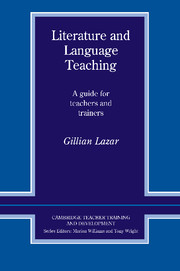Book contents
- Frontmatter
- Contents
- Thanks
- Acknowledgements
- Introduction
- 1 Using literature in the language classroom: The issues
- 2 Approaches to using literature with the language learner
- 3 Selecting and evaluating materials
- 4 Reading literature cross-culturally
- 5 Materials design and lesson planning: Novels and short stories
- 6 Materials design and lesson planning: Poetry
- 7 Materials design and lesson planning: Plays
- 8 Reflecting on the literature lesson
- 9 Literature and self-access
- Answer key
- Trainer's notes
- Bibliography
- Appendix: Eveline by James Joyce
- Index
7 - Materials design and lesson planning: Plays
Published online by Cambridge University Press: 04 May 2010
- Frontmatter
- Contents
- Thanks
- Acknowledgements
- Introduction
- 1 Using literature in the language classroom: The issues
- 2 Approaches to using literature with the language learner
- 3 Selecting and evaluating materials
- 4 Reading literature cross-culturally
- 5 Materials design and lesson planning: Novels and short stories
- 6 Materials design and lesson planning: Poetry
- 7 Materials design and lesson planning: Plays
- 8 Reflecting on the literature lesson
- 9 Literature and self-access
- Answer key
- Trainer's notes
- Bibliography
- Appendix: Eveline by James Joyce
- Index
Summary
This chapter, which examines the place of plays in the language classroom, begins by discussing the distinctive features of plays and how plays can be exploited in the classroom. Ways of using both play extracts and whole plays are examined. A section on using play extracts with learners at lower levels and a section on preparing students for a theatre visit are included.
What is distinctive about plays?
Following the pattern of the previous two chapters, we will begin by discussing what is meant by a play and its similarities and differences to other literary genres. First let us examine the two quotations below.
A. … drama is not made of words alone, but of sights and sounds, stillness and motion, noise and silence, relationships and responses.
(J. L. Styan, 1975, Drama, Stage and Audience.)B. However familiar or unfamiliar the world of a tragedy, comedy, farce or melodrama may be, everything that we experience has its source, in the long run, in words.
(Gareth Lloyd Evans, 1977, The Language of Modern Drama.)Task 1
a) Think about a play that you know well, either in English or another language. If you have seen the play performed, what examples of ‘sights and sounds, stillness and motion, noise and silence’ do you remember from the play? What examples of ‘relationships and responses’ can you remember? If you have read it, were you able to recreate these in your imagination?
b) How important were the words in the play? Could you imagine the play rewritten in another style? Would it still have the same effect?
[…]
- Type
- Chapter
- Information
- Literature and Language TeachingA Guide for Teachers and Trainers, pp. 133 - 166Publisher: Cambridge University PressPrint publication year: 1993

